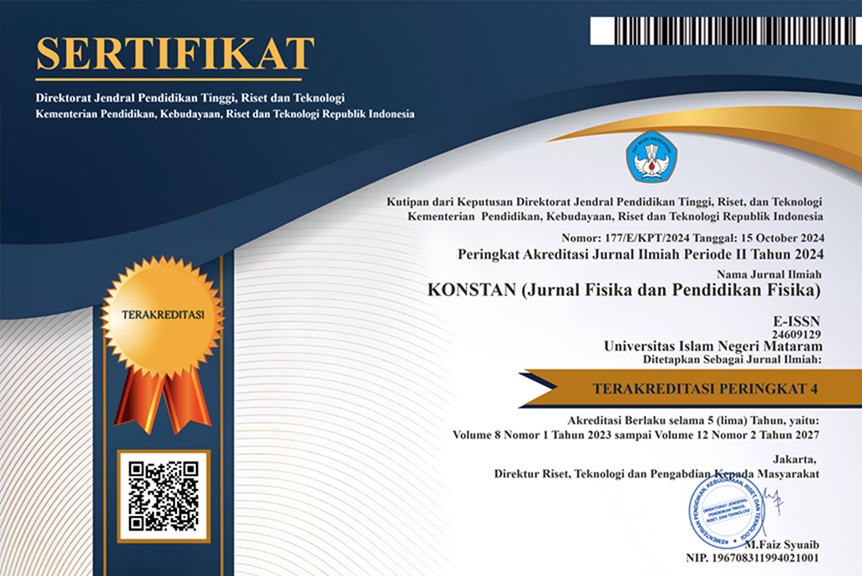Identifying Student Misconceptions Using Three-Tier Test with Certainty of Response Index on Temperature and Heat Topics
Abstract
This research aims to identify students' misconceptions using a Three-Tier diagnostic test assisted by the Certainty of Response Index (CRI) on temperature and heat material. The data analysis method used in this research is quantitative descriptive and equipped with a three-tier Certainty of Response Index (CRI). The population in this study was class XI 1 IPA MAN 1 Musi Banyuasin with 30 students, and the sample in this study was class. Data collection techniques were used during the observation, test, and documentation stages. The research results showed that the misconceptions identified regarding the concept of temperature and heat were 40%, 36% understood the concept, 6% understood the concept but needed clarification and 18% needed to learn the concept. The misconceptions experienced by students are classified as moderate-level misconceptions with a percentage range of 31% ≥ 60%. The cause of misconceptions is the students' errors in learning context and incomplete reasoning. It is hoped that the results of this research can provide information about misconceptions that occur in the matter of temperature and heat and can serve as a guide for further research to find out the causes of misconceptions and efforts to overcome them.
Downloads
References
[2] A. Syahrul, Dimas, and S. Woro, “Identifikasi Miskonsepsi dan Penyebab Miskonsepsi Siswa dengan Three-tier Diagnostic Test Pada Materi Dinamika Rotasi,” J. Inov. Pendidik. Fis., vol. 04, no. 03, pp. 67–70, 2015.
[3] F. Yolviansyah, M. Maison, and D. A. Kurniawan, “Identifikasi Miskonsepsi Peserta Didik Pada Pembelajaran FisikIdentifikasi Miskonsepsi Peserta Didik Pada Pembelajaran Fisika di SMA N 8 Kota Jambia di SMA N 8 Kota Jambi,” Edumaspul J. Pendidik., vol. 6, no. 1, pp. 541–545, 2022, doi: 10.33487/edumaspul.v6i1.3164.
[4] H. Aprilanti, M. Qurbaniah, and N. D. Muldayanti, “Identifikasi Miskonsepsi Siswa Pada Materi Sistem Ekskresi Manusia Kelas Xi Mia Sma Negeri 4 Pontianak,” J. Bioeducation, vol. 3, no. 2, pp. 63–77, 2016, doi: 10.29406/188.
[5] P. Suparno, Miskonsepsi dan Perubahan Konsep dalam Pendidikan Fisika. Jakarta: PT Grasindo, 2018.
[6] S. Hasan, D. Bagayoko, and E. L. Kelley, “Misconceptions and the certainty of response index (CRI),” Phys. Educ., vol. 34, no. 5, pp. 294–299, 1999, doi: 10.1088/0031-9120/34/5/304.
[7] M. B. Atsilah, S. Suhadi, J. K. Putri, F. Mabruroh, S. Sugiarti, and J. Pebralia, “Pengembangan Three Tier Test Multiple Choice Untuk Mengidentifikasi Miskonsepsi Pada Materi Hukum Newton,” J. Penelit. Pembelajaran Fis., vol. 15, no. 2, pp. 213–221, 2024, doi: 10.26877/jp2f.v15i2.18045.
[8] Riduan, “Metode dan Teknik Menyusun Tesis,” in Alfabeta, Bandung, 2004. doi: 10.37478/jpm.v3i3.2024.
[9] Y. R. Tayubi, “Identifikasi Miskonsepsi pada Konsep-Konsep Fisika Menggunakan Certainty of Response Index (CRI),” J. UPI, vol. 24, no. 3, p. 5, 2005.
[10] T. A. Mustakim, Z. Zulfiani, and Y. Herlanti, “Identifikasi Miskonsepsi Siswa Dengan Menggunakan Metode Certainty of Response Index (Cri) Pada Konsep Fotosintesis Dan Respirasi Tumbuhan,” Edusains, vol. 6, no. 2, 2015, doi: 10.15408/es.v6i2.1117.
[11] A. D. L. Nita dwi Handayani, Sri Astutik, “Identifikasi Miskonsepsi Siswa Menggunakan Four-Tier Diagnostic Test Pada Materi Hukum Termodinamika di SMA Bondowoso,” J. Pembelajaran Fis., vol. 7, no. 2, pp. 189–195, 2022.
[12] S. Kesidou and R. Duit, “Students’ conceptions of the second law of thermodynamics—an interpretive study,” J. Res. Sci. Teach., vol. 30, no. 1, pp. 85–106, 1993, doi: 10.1002/tea.3660300107.
[13] Haliday; Rasnick;, “Fisika Dasar Jilid 1,” in Angewandte Chemie International Edition, 6(11), 951–952., 7th ed., Jakarta: Erlangga, 2012.
[14] D. . Giancoli, Fisika Jilid 1, 1st ed. Jakarta: Erlangga, 2001.
[15] S. M. Z. Yeo, “Introductory Thermal Concept Evaluation (Assessing Students Understanding),” Phys. Teach., vol. 39, 2001.



